by
Selena Blue, Editorial Content Manager
After 10 years of MarketingSherpa Email Summit, we opened our doors to all marketers with the launch of MarketingSherpa Summit 2016. This year's event featured three tracks to choose from: Email & Mobile, Data & Digital and Content & Social.
To give these tracks the attention they deserve, we're also breaking our annual wrap-up article into three parts.
In this article, you'll find the top takeaways from the Content & Social track, including insights from six of our brand-side marketing speakers.
Takeaway #1. Let your customer speak for you
When you make claims about your product or service, prospective customers will have a certain level of skepticism about how valid those claims are. After all, you're trying to sell them on it.
However, research has found online reviews a powerful influencer in customer buying decisions. In fact, 88% of consumers trust online customer reviews as much as personal recommendations, according to a
study by BrightLocal.
But you don't have to stop at reviews. The following two companies at Summit have found other ways to let customers speak to the value their products and services provide.
Share customers' social media content
The customers of Door to Door Organics were sharing photos of their produce and grocery deliveries on Instagram before the company was even on the platform.
For customers, receiving their box "felt like Christmas every Tuesday when they opened that farm fresh deliciousness," Cambria Jacobs, Vice President of Marketing and Customer Service, Door to Door Organics, said.
This common experience is what inspired the company's tagline and hashtag, #joydelivered. It also inspired the team to curate these social shares and let their customers speak for them by "showcasing their experience."
The team
repurposed these pictures in two key ways: simply reposting the image on Facebook or Instagram, or by incorporating the image into promotional offer.
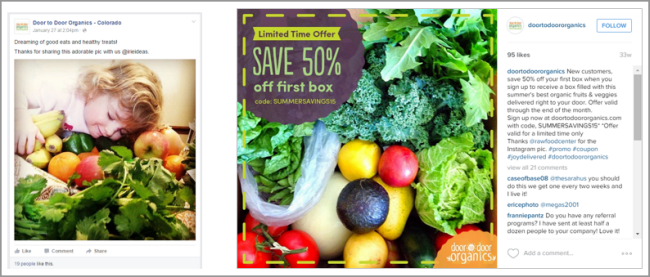
Click here to see the full version of this creative sample
While the team could easily have staged pictures of produce for their ads, using customers' real-life photos both allows prospective customers a glimpse of what they would be really receiving and allows current customers to feel appreciated and seen.
Use a contest to secure success stories
HCSS, a construction software company, knew it had amazing client stories. However, getting busy construction customers to share those stories wasn't easy.
Knowing their customers can be a bit competitive, the team decided to try a March Madness-style contest called the "
Most Interesting Project Bracket Challenge."
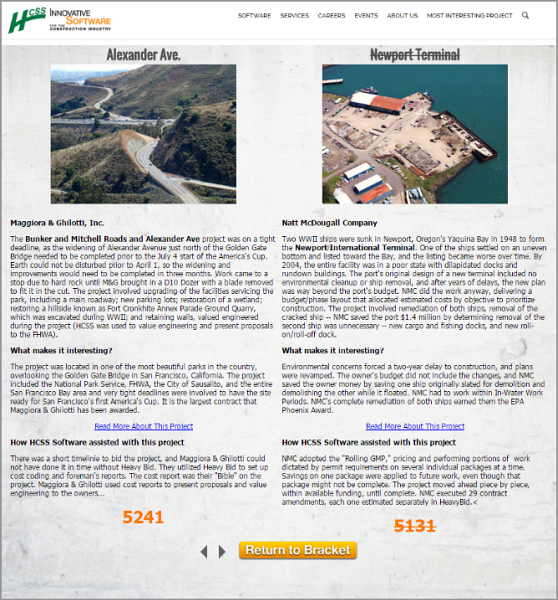
Click here to see the full version of this creative sample
They used email, social media and blog content to inform customers of the launch of the bracket competition, as well as incentivized their own employees to personally reach out to their clients.
The results?
"We were hoping for maybe 16 [submissions] so we didn't embarrass ourselves, but we were blown away when we got 117," Dan Briscoe, Vice President of Marketing, HCSS, said.
While each entry mainly focused on the project itself, the team also briefly highlighted how HCSS Software helped in the success of the project.
The contest was a big hit with customers, with even a local news station picking up the contest to highlight a local project in the competition.
The team saw a 880% lift in Web visits during the five-week contest. They also saw a 633% lift in social media traffic. Beyond numbers, the marketing team also saw a change in how they were perceived internally.
"Before the contest, we were viewed as a print shop. This really put us on the map and showed what we could do," Briscoe said.
Takeaway #2. Relevant, valuable content can shorten sales cycles
It's no secret content marketing is a powerful tool. However, two companies at MarketingSherpa Summit were able to create and use content to better inform prospects and shorten sales cycles.
Take a multichannel approach
PR Newswire used a
five-part marketing infrastructure to support its efforts:
- Content
- Marketing technology
- Lead management process
- Multichannel promotion
- Data and analytics

Click here to see the full version of this creative sample
At the core of the infrastructure was a focus on a buyer insight-focused cycle but it was the multichannel presence that really accelerated the buying process for the company.
The team used a multichannel content strategy at different phases of the buyer decision process to move prospects up the funnel.
"You have to join your team's objectives to the buyer's journey," Ken Wincko, Senior Vice President of Marketing, PR Newswire, said.
The team conducted research around the impact of coordinated channel promotion, as well as the timing of promotions, finding that a multichannel distribution within a one-week timeframe saw significant increases in both views and downloads.
The team constantly monitors the contribution levels each channel provides to the end results in an effort to continually optimize their channel strategy.
This all boils down to one thing for the PR Newswire team, Wincko said:
"Great marketing is not about selling —
it's about serving."
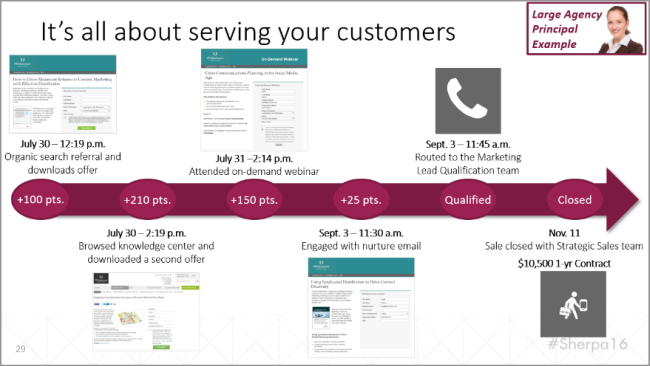
Click here to see the full version of this creative sample
The team also saw great results from the strategy:
- More than 20% lift in qualified leads
- 1% incremental topline growth
- Shortened the sales cycle by over a third
Content shouldn't be about selling or marketing. According to Wincko, it should be about providing your customers with valuable content that helps them in their efforts whether they choose to go with you or not.
Trust your customers to raise their hands
For Health Catalyst, a healthcare analytics company, aggressively educating customers was a key aspect to in its strategy to deliver a high-growth pipeline of leads. However, in a crowded healthcare IT market, it wanted to establish leadership, not generate cold leads.
This led the team to take a different approach: as few lead forms as possible. Because they wanted a pipeline of sale-ready leads, they put their trust in prospects to raise their hands when they were ready.
To get them ready, Health Catalyst built a robust knowledge center for prospects and customers to learn about topics that mattered to them. The team realized this would be a big commitment and would require content to be the focus of the team.
"Seventy-five percent is dedicated to content creation," Chris Keller, Vice President of Marketing, Health Catalyst, said.
The knowledge center included:
- Articles
- Customer success stories
- Documentaries
- Handbooks
- Webinars
Prospects can access nearly all content without filling out a form.
For webinars, an email is required due to needing to send the invite. However, attending the webinar doesn't automatically push a prospect to sales-ready status. Instead, the webinars spend just a minute or two of 60 minutes asking a
poll question of interest in a product demo. Only attendees "very interested" are followed up with by sales.
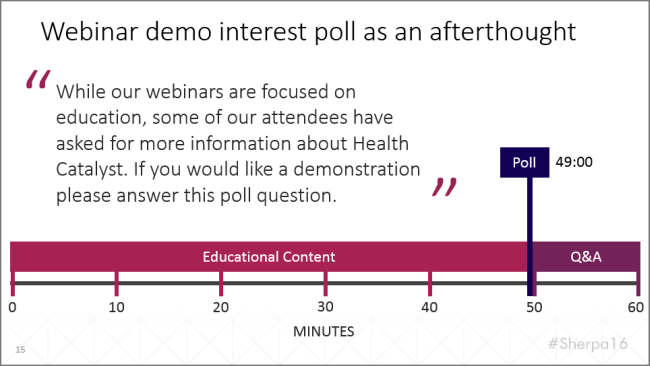
Click here to see the full version of this creative sample
The team does use tracking, Web analytics and reverse IP lookup to monitor both named and anonymous prospects. This allows them to have a better understand of customers when they do raise their hands.
It also helps the Sales team better serve customers by knowing what content they've looked at and engaged with.
This effort decreased the sales cycle by 33%, and also saw a 300% increase in leads and a 550% increase in clients.
Takeaway #3. Short-form video can be a powerful attraction tool
In a crowded space, whether online or physically at a trade show, it can be tough to stand out and attract attention.
In the "Attract" portion of the Content & Social breakout track at Summit, two very different companies shared how short-form video helped them attract their target audiences.
Use curiosity to entice people to learn more
For Toshiba Medical Increased, RSNA is one of its biggest trade shows of the year — it's also one of the nosiest socially.
Before settling on a strategy, it looked at the previous year's results.
"We looked at our data we had in-house. We wanted to know what worked and what didn't. You'd be amazed at how much information you have in your organization even without fancy technology," Rose Mary Moegling, Manager of Customer Engagement, Toshiba America Medical Systems, Inc, said.
Video emerged as the strategy the team would focus on, but they wanted to improve on the previous year's video strategy. Looking at the video performance of 2013's event, they saw
a pattern.
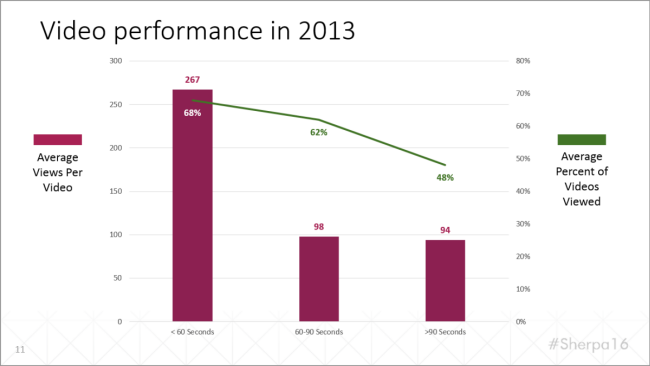
Click here to see the full version of this creative sample
The shortest videos received significantly more views, as well as increased average percent watched.
While the 2013 videos averaged around two minutes in length, the team cut the videos for 2014 down to just 20 seconds on average.
Instead of trying to answer everything about the product in the video, the team the team hit on one point: "We know your problem, we have a solution for you."
Short and to the point, the video would then direct viewers to the team's booth at the event to learn more.
"You have an issues, here's how we can help. Then drive them to the website or booth, hand it over to the salespeople and let them provide the additional needed value," Moegling said.
The new video strategy saw a 180% increase in views. The team also received a 12.6% increase in booth traffic — which was the real goal of the shift.
Surprise and delight audiences
In a competitive marketplace for high-end jewelry, the Brian Gavin Diamonds team needed a cost-effective method to help them stand out. They had a long history of product innovation, and weren't afraid of going somewhere the competition had yet to go.
"The natural paths of marketing can be more expensive. We turned to social," Danny Gavin, Vice President, Director of Marketing, Brian Gavin Diamonds, said.
This led them to the video platform, Vine. The platform allows for only six seconds of looping video clips.
"No one in the jewelry business was using Vine. It was a wide open playing field," Gavin said.
While six seconds is not a lot of time to tell a story, the team has come up with a four-part strategy to their videos:
- Don't oversell
- Be true to the platform
- Be timely and relevant
- Distill
Here's an example of one Vine video that quickly showcases what the company can do with the caption, "From idea, to design, to the custom engagement ring of your dreams ... Brian Gavin Diamonds is a cut beyond brilliant."
The team has seen some great results for emails with Vine content:
- 23% increase in open rate
- 1,241% increase in CTR
Despite there being no direct lines in the Vine platform, the team as seen 20% increase in direct traffic and 13% increase in year-over-year total traffic. While they can't attribute that completely to Vine, Gavin felt confident it had a significant impact on the increases.
About working in uncharted platforms, Gavin told attendees, "You have to just jump, and don't be afraid."
Join us on March 9 for the post-Summit wrap-up webinar where the MarketingSherpa Editorial Team will discuss the most inspirational and actionable lessons from this year's two-day event in only one hour.Related Resources
Email Marketing: 5 actionable tips and tactics from your peers at MarketingSherpa Summit 2016Inbound Marketing: Family-owned business competes with industry leaders through Vine campaignTop Takeaways of MarketingSherpa Summit 2016 [MECLABS webinar]
Email Marketing: How content and testing boosted revenue 114% at IAC subsidiary HomeAdvisorEmail Marketing: Last-minute holiday deals preview wins with customer-centric approachEmail Marketing: Pinterest email test results in 31% lift in re-pins from email















